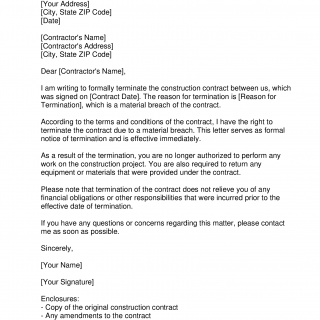Construction Contract Termination Letter
A Construction Contract Termination Letter is a legal document used to formally terminate a construction contract between two parties. This letter is usually written by the party who wishes to terminate the contract and is sent to the other party.
The main purpose of this letter is to end the construction contract between the parties due to various reasons such as breach of contract, non-performance, or other significant issues. The letter should include the reason for termination and the effective date of termination.
The letter should consist of the following parts:
- Introduction: This should include the name of the parties involved and the purpose of the letter.
- Reason for termination: This should clearly state the reason for terminating the contract.
- Effective date of termination: This should indicate the date when the contract will officially end.
- Consequences of termination: This should outline the consequences of terminating the contract, including any financial obligations or other responsibilities.
- Instructions for next steps: This should provide instructions for the next steps that need to be taken, such as returning any equipment or materials that were provided under the contract.
The parties involved in the construction contract termination letter are the contractor and the client. It is important to consider the terms and conditions of the contract before writing the termination letter. The letter should be carefully drafted to avoid any legal complications.
When writing the letter, the following data will be required:
- Names and addresses of the parties involved
- Contract number and date
- Reason for termination
- Effective date of termination
Additional documents that must be attached include the original construction contract, any amendments to the contract, and any correspondence related to the contract termination.
Application examples and use cases for this letter include terminating a construction contract due to non-performance, breach of contract, or other significant issues. It is important to follow the terms and conditions outlined in the original contract and to seek legal advice before terminating the contract.
Strengths of this letter include providing a formal and legal way to terminate a construction contract, while weaknesses include the potential for legal complications if the letter is not drafted carefully.
Sample of Construction Contract Termination Letter
[Your Name]
[Your Address]
[City, State ZIP Code]
[Date][Contractor's Name]
[Contractor's Address]
[City, State ZIP Code]Dear [Contractor's Name],
I am writing to formally terminate the construction contract between us, which was signed on [Contract Date]. The reason for termination is [Reason for Termination], which is a material breach of the contract.
According to the terms and conditions of the contract, I have the right to terminate the contract due to a material breach. This letter serves as formal notice of termination and is effective immediately.
As a result of the termination, you are no longer authorized to perform any work on the construction project. You are also required to return any equipment or materials that were provided under the contract.
Please note that termination of the contract does not relieve you of any financial obligations or other responsibilities that were incurred prior to the effective date of termination.
If you have any questions or concerns regarding this matter, please contact me as soon as possible.
Sincerely,
[Your Name]
[Your Signature]
Enclosures:
- Copy of the original construction contract
- Any amendments to the contract
- Correspondence related to the contract termination
Alternative forms and analogues of this letter include a Mutual Termination Agreement, which is a document that both parties sign to terminate the contract. The main difference between the two is that the Construction Contract Termination Letter is a one-sided document, while the Mutual Termination Agreement requires both parties to agree to end the contract.
Submitting the letter depends on the terms of the original contract, but it is usually sent via certified mail or email. It should be stored in a secure location for future reference. The letter can affect the future of the participants by releasing them from their obligations under the contract and allowing them to move on to other projects.

